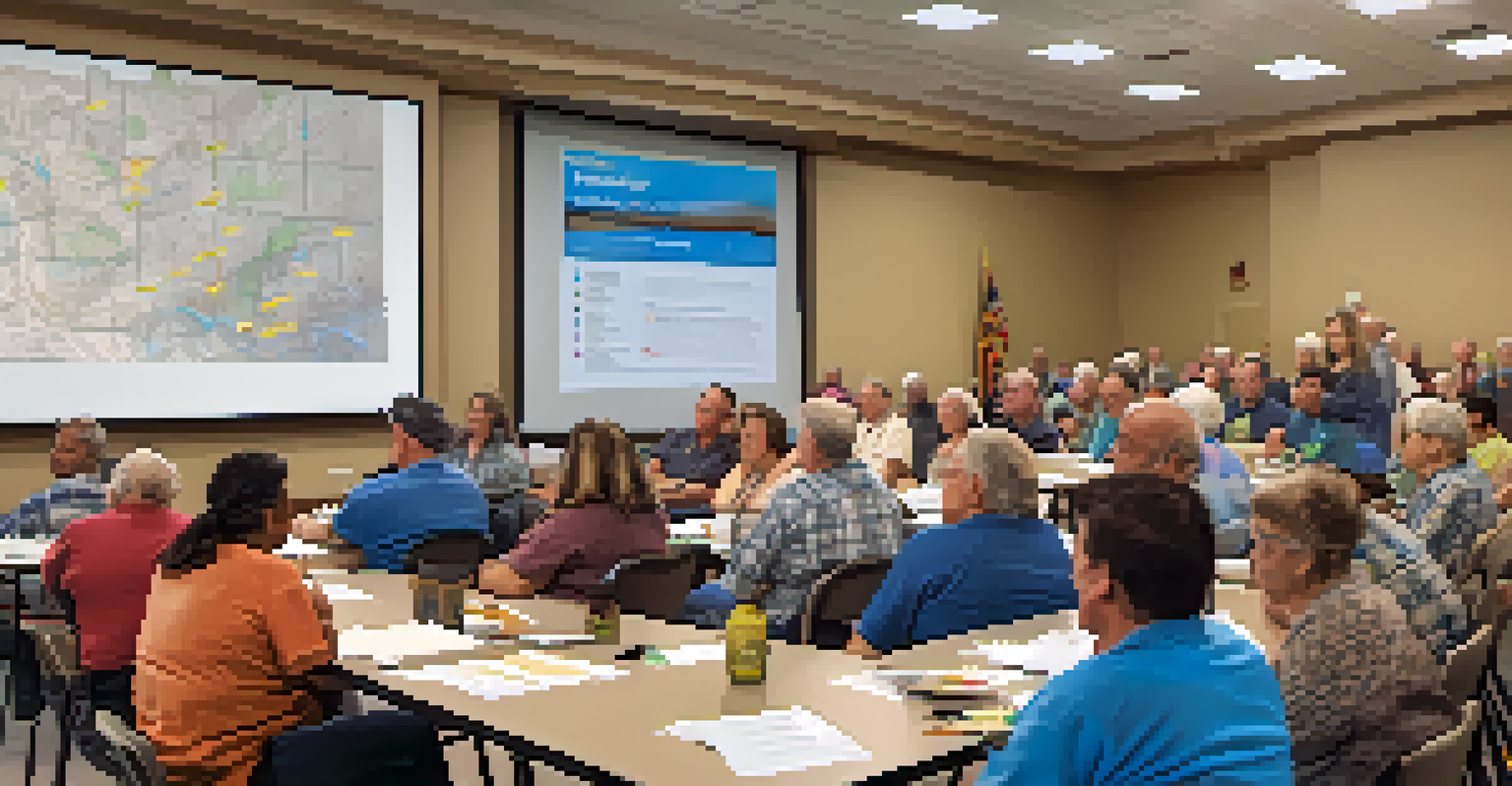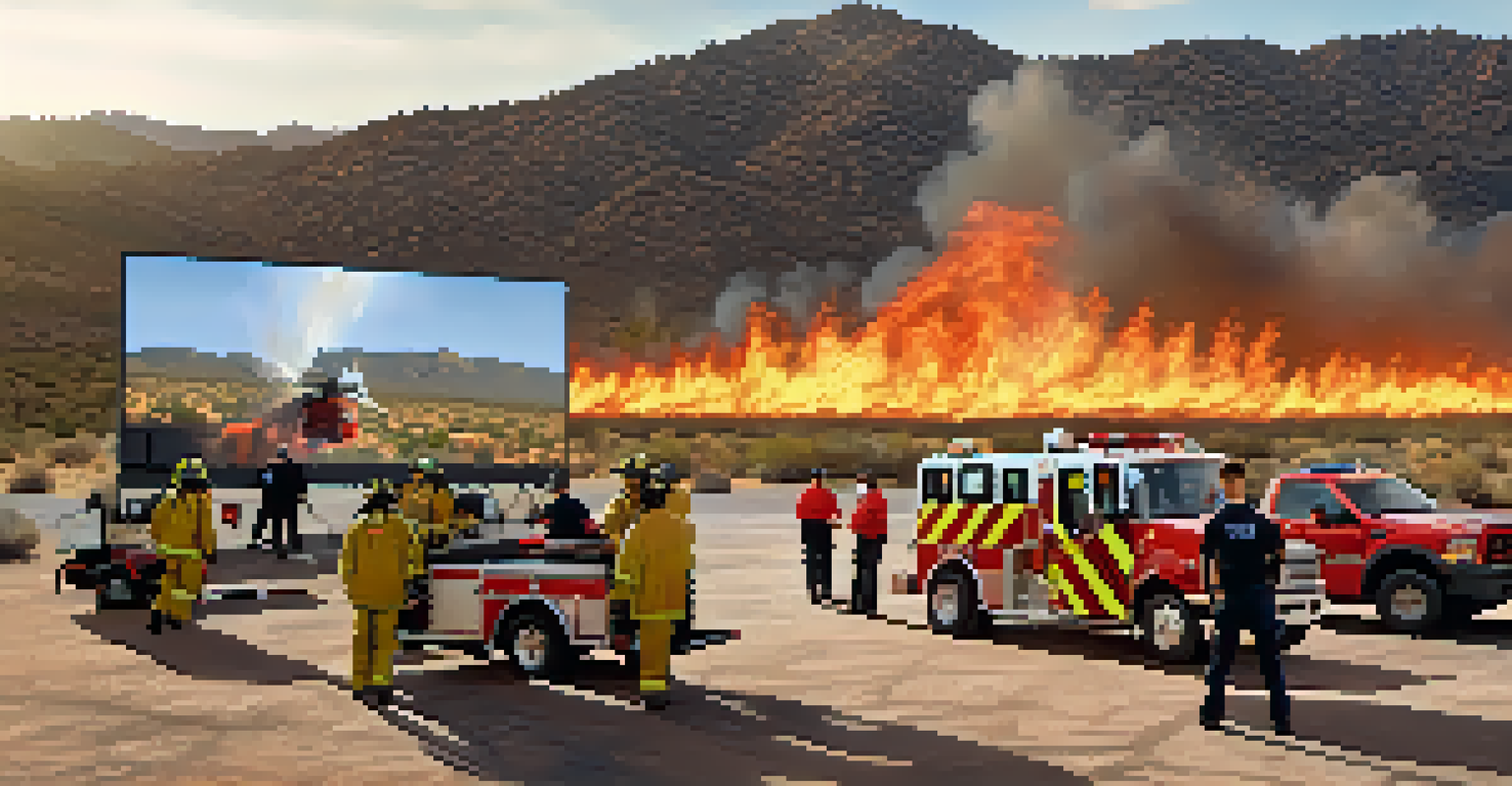Wildfire Preparedness: Arizona's Emergency Response Framework

Understanding Arizona's Wildfire Risk and Challenges
Arizona is home to diverse ecosystems, which unfortunately make it prone to wildfires. The state’s dry climate and varying landscapes create ideal conditions for fires to ignite and spread rapidly. Factors like drought, high winds, and human activity can exacerbate these risks, leading to devastating consequences for communities and wildlife.
Wildfires are a natural part of many ecosystems, but human activity and climate change are making them more frequent and intense.
In recent years, the frequency and intensity of wildfires have increased, prompting state officials to reassess their strategies. The consequences of these fires are not just environmental; they threaten homes, infrastructure, and even lives. Understanding the risks is the first step toward effective preparedness and response.
By recognizing the unique challenges posed by Arizona’s geography and climate, residents and officials can work together to develop robust strategies. This proactive approach not only mitigates the impact of wildfires but also fosters a culture of safety and resilience within communities.
The Importance of Community Engagement in Wildfire Preparedness
Community engagement is crucial for effective wildfire preparedness in Arizona. When residents actively participate in planning and response strategies, the overall safety of the community improves significantly. This collaborative effort can include everything from attending local meetings to participating in fire safety training programs.

Local organizations and agencies often provide resources and information to help residents understand their roles in wildfire preparedness. By fostering a sense of shared responsibility, communities can create stronger networks of support and communication during fire emergencies. This engagement can also lead to increased awareness of evacuation routes and safety protocols.
Wildfire Risks Demand Community Action
Active community engagement is vital for enhancing wildfire preparedness and building resilience in Arizona.
Moreover, engaged communities tend to be more resilient in the face of disasters. When neighbors look out for one another and share knowledge, it creates a safety net that can make all the difference during a crisis. Therefore, building a culture of preparedness through community engagement is vital for Arizona.
Arizona's Emergency Response Framework: An Overview
Arizona's Emergency Response Framework is designed to provide a structured approach to wildfire management. This framework outlines clear roles and responsibilities for various agencies, ensuring a coordinated response during emergencies. By establishing a comprehensive plan, the state can respond swiftly and effectively to wildfire threats.
In the face of disaster, community engagement and preparedness can save lives and protect homes.
The framework integrates various elements, including prevention, preparedness, response, and recovery. Each stage plays a critical role in minimizing the impact of wildfires on communities and ecosystems. For example, the prevention strategies involve controlled burns and vegetation management to reduce fuel loads in high-risk areas.
Through this structured approach, Arizona can better allocate resources and deploy personnel where they are needed most. The framework not only enhances the state's ability to respond to wildfires but also fosters collaboration among local, state, and federal agencies, ensuring a united front against these natural disasters.
Key Components of Arizona's Wildfire Response Strategy
Arizona's wildfire response strategy includes several key components that work together to ensure effective management of emergencies. One crucial element is the establishment of Incident Command Systems (ICS), which create a clear chain of command during wildfire events. This system allows for rapid decision-making and resource allocation, essential in high-pressure situations.
Additionally, Arizona employs advanced technology for monitoring and assessing wildfire risks. Tools like satellite imagery and real-time data analysis help officials predict fire behavior and make informed decisions. These technological advancements can significantly enhance the state’s ability to respond quickly and efficiently.
Collaboration Strengthens Response Plans
Effective wildfire management relies on collaboration between state and local agencies to tailor strategies for specific community needs.
Moreover, community training programs are an integral part of the response strategy. By equipping residents with knowledge on evacuation procedures and fire safety, Arizona empowers individuals to act decisively in emergencies. This combination of technology, training, and structured response plays a vital role in mitigating wildfire impacts across the state.
State and Local Collaboration in Wildfire Preparedness
Collaboration between state and local agencies is essential for effective wildfire preparedness in Arizona. By working together, these entities can pool resources, share expertise, and develop comprehensive strategies that address the unique needs of different communities. This teamwork enhances the overall effectiveness of wildfire management efforts.
Local fire departments often play a critical role in these collaborations, providing firsthand knowledge of their communities and specific risks. State agencies can then support these efforts through funding, training, and resources. This synergy ensures that preparedness initiatives are tailored to the local context, making them more relevant and impactful.
Furthermore, regular communication between state and local agencies fosters trust and transparency. When communities feel confident in their leaders' ability to manage wildfire risks, they are more likely to engage in preparedness activities. This collaborative approach ultimately leads to stronger, more resilient communities ready to face wildfire challenges.
Public Education and Awareness Campaigns on Wildfire Risks
Public education and awareness campaigns are vital for informing Arizona residents about wildfire risks and preparedness measures. These initiatives aim to empower individuals with knowledge, enabling them to take proactive steps to protect themselves and their property. By raising awareness, the state can foster a culture of preparedness that extends beyond emergency situations.
Campaigns often utilize various channels, including social media, community workshops, and informational brochures. These resources provide valuable insights into wildfire behavior, evacuation routes, and fire safety tips. By making this information accessible, Arizona encourages residents to stay informed and prepared year-round.
Future Preparedness Requires Innovation
Integrating advanced technologies and fostering partnerships with research institutions will enhance Arizona's wildfire preparedness and response strategies.
Moreover, engaging storytelling can make these campaigns even more impactful. Sharing real-life experiences and lessons learned from previous wildfires helps residents relate to the risks and motivates them to take action. In this way, public education serves as a critical tool in reducing the potential impact of wildfires on communities.
Future Directions in Wildfire Preparedness in Arizona
As climate change continues to influence wildfire patterns, Arizona's approach to preparedness must evolve. Future directions include incorporating innovative technologies, such as artificial intelligence and machine learning, to enhance risk assessment and response strategies. These advancements can provide state officials with more precise data for better decision-making.
Additionally, fostering partnerships with research institutions can facilitate the development of new strategies for wildfire prevention and response. By leveraging scientific expertise, Arizona can implement evidence-based practices that effectively address emerging wildfire challenges. This collaboration can also lead to more effective public education initiatives.

Lastly, continuous training and development for emergency responders will be crucial in adapting to new wildfire dynamics. As the landscape of wildfires changes, so too must the skills and knowledge of those on the front lines. Embracing these future directions will help Arizona build a more resilient framework for wildfire preparedness and response.